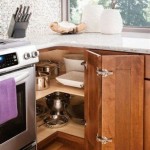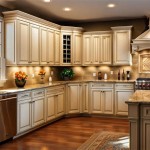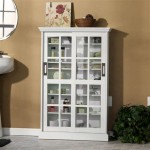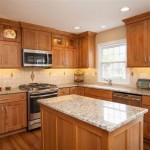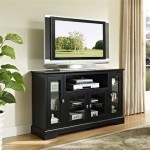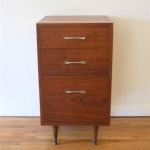What Is A Full Overlay Cabinet?
Full overlay cabinets, also known as frameless cabinets or European-style cabinets, represent a modern and sleek approach to cabinet design. Unlike traditional framed cabinets, where the cabinet frame is visible around the door and drawer fronts, full overlay cabinets minimize the visible frame, creating a more streamlined and contemporary aesthetic. This design choice has gained considerable popularity in recent years due to its clean lines, increased storage space, and versatility in adapting to various design styles. Understanding the nuances of full overlay cabinets is crucial for homeowners, designers, and contractors embarking on kitchen or bathroom renovation projects.
The defining characteristic of a full overlay cabinet lies in how the door and drawer fronts cover the cabinet box. In this design, the doors and drawer fronts completely, or nearly completely, cover the cabinet face, leaving only a minimal gap between adjacent doors and drawers. This creates a seamless appearance, offering a more modern and minimalist look compared to framed cabinets.
To understand the advantages and disadvantages of full overlay cabinets, a detailed examination of their construction, installation, and overall aesthetic impact is necessary. This exploration will cover the key benefits, potential drawbacks, and considerations for incorporating full overlay cabinets into various design schemes.
Key Point 1: Construction and Design Features
The construction of full overlay cabinets differs significantly from that of traditional framed cabinets. Framed cabinets, as the name suggests, feature a face frame that is attached to the front of the cabinet box. This frame provides structural support and a surface for attaching doors and drawers. In contrast, full overlay cabinets typically utilize a frameless construction technique.
Frameless construction relies on thicker cabinet box materials, typically ¾-inch plywood or particleboard, to provide the necessary structural integrity. The edges of these materials are often finished with edge banding to create a clean and durable surface. Doors and drawers are then attached directly to the cabinet box using specialized hinges and mounting hardware.
The hinges used in full overlay cabinets are a critical component. These hinges are typically concealed hinges, meaning they are not visible when the doors are closed. They allow for precise adjustment, ensuring that the doors and drawers align properly and operate smoothly. The adjustability of these hinges is crucial for maintaining the seamless appearance characteristic of full overlay designs.
Full overlay cabinet doors are often larger than those used in framed cabinets, as they are designed to cover the entire cabinet face. This necessitates a higher degree of precision in manufacturing and installation. Any imperfections can become more noticeable due to the larger surface area of the doors and drawers.
The design of full overlay cabinets also allows for greater flexibility in terms of interior organization. Because there is no face frame obstructing access, drawers and pull-out shelves can be wider and deeper, maximizing storage space. This is a significant advantage for homeowners seeking to optimize their kitchen or bathroom storage.
Key Point 2: Advantages and Disadvantages
Full overlay cabinets offer several distinct advantages that contribute to their growing popularity. One of the primary benefits is the modern and streamlined aesthetic. The minimal frame visibility creates a clean and uncluttered look that is well-suited to contemporary and minimalist design styles. This aesthetic appeal can significantly enhance the overall visual impact of a kitchen or bathroom.
Another key advantage is the increased storage capacity. The frameless construction allows for wider and deeper drawers and pull-outs, maximizing the usable space inside the cabinets. This is particularly beneficial in smaller kitchens or bathrooms where space is at a premium. The absence of a face frame also simplifies access to items stored within the cabinets.
Full overlay cabinets can also offer greater design flexibility. The clean lines and minimalist aesthetic make them adaptable to a wide range of design styles, from modern and contemporary to transitional and even some traditional designs. The doors and drawer fronts can be customized with various materials, finishes, and hardware to create a unique and personalized look.
However, full overlay cabinets also have some potential disadvantages that should be considered. One of the primary drawbacks is the higher cost compared to traditional framed cabinets. The frameless construction requires more precise manufacturing and higher-quality materials, which can increase the overall cost of the cabinets. The specialized hinges and mounting hardware also contribute to the higher price point.
Installation of full overlay cabinets can also be more challenging than that of framed cabinets. The precise alignment and adjustment required to achieve the seamless look necessitates a higher level of skill and expertise. Improper installation can result in misaligned doors and drawers, detracting from the overall aesthetic appeal. Professional installation is often recommended to ensure a satisfactory outcome.
Another potential disadvantage is the increased susceptibility to damage. Because the doors and drawer fronts are larger and cover a greater surface area, they are more vulnerable to scratches, dents, and other types of damage. Careful handling and maintenance are essential to preserve the appearance of full overlay cabinets.
Key Point 3: Installation and Considerations
The installation process for full overlay cabinets requires careful planning and execution. The first step is to ensure that the cabinet boxes are level and plumb. Any imperfections in the floor or walls can affect the alignment of the doors and drawers, compromising the overall aesthetic appeal. Shimming may be necessary to compensate for uneven surfaces.
The specialized hinges used in full overlay cabinets are typically adjustable, allowing for fine-tuning of the door and drawer alignment. These hinges are often equipped with multiple adjustment screws that control the vertical, horizontal, and depth positioning of the doors and drawers. Careful adjustment is crucial to achieve the desired seamless look.
When installing full overlay cabinets, it is important to consider the spacing between adjacent doors and drawers. A consistent gap of approximately 1/8 inch is typically recommended to allow for expansion and contraction of the materials due to changes in temperature and humidity. This gap also prevents the doors and drawers from rubbing against each other, which can cause damage to the finish.
The choice of hardware, such as handles and knobs, can also impact the overall aesthetic of full overlay cabinets. Modern and minimalist hardware styles are often preferred to complement the clean lines and streamlined appearance of the cabinets. The hardware should be selected carefully to ensure that it is both functional and aesthetically pleasing.
Another important consideration is the selection of materials and finishes. Full overlay cabinets can be constructed from a variety of materials, including plywood, particleboard, and MDF. The choice of material will depend on factors such as budget, durability requirements, and aesthetic preferences. The finish can also significantly impact the overall look of the cabinets. Options include paint, stain, laminate, and veneer. The finish should be durable and easy to clean, as cabinets are often subjected to wear and tear.
Furthermore, homeowners considering full overlay cabinets should be aware of the potential for increased cleaning efforts. While the minimalist design can appear cleaner, the smaller gaps between doors and drawers can accumulate dust and debris. Regular cleaning with appropriate cleaning products is required to maintain the appearance of the cabinets.
Finally, it’s essential to factor in the potential for future maintenance and repairs. While full overlay cabinets are generally durable, they are not immune to damage. Scratches, dents, and other types of damage may require professional repair or even replacement of the affected door or drawer. It is advisable to keep extra paint or stain on hand for touch-ups.

What Is Cabinet Door Overlay Woodworker Express

What Is Full Overlay Definition Of

Measuring For Your New Cabinet Doors Joint

Understanding Overlay Cabinet Doors Cabinetry Design 101

Full Overlay Doors Standard Cabinet Collection

Full Overlay Tutorial

Full Overlay Tutorial

Face Frame Vs Frameless Kitchen Cabinets

Full Overlay Standard Cabinets Diamond Kitchen And Bath

Inset Vs Overlay Cabinets Which Type Is Right For You

